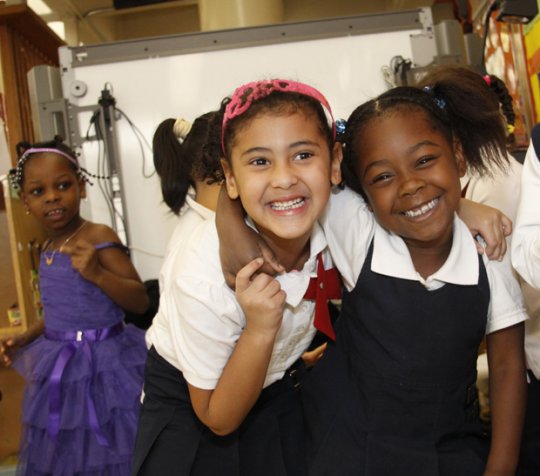Unit 4: Lesson 12
Select & Assign Characters’ and Seedfolks Themes for Seedfolks Composition; Rehearse
LITERACY OBJECTIVE
By the end of this lesson students will be able to reflect on the story and characters to revise themes for the final performance.
LITERACY "I CAN" STATEMENT
"I can reflect on what I've learned about the story and my character and revise my theme for the final performance."
LESSON OVERVIEW
| Steps |
Pacing: 45-60 Minutes |
|
|
10 Minutes |
| |
5 -15 Minute break to assign themes |
|
|
35 Minutes |
*Lesson 12 is written to be 45–60 minutes long. However, it needs to be broken up into two segments. Students need 10–15 minutes to discuss what they’d like to perform in the whole class Seedfolks Composition. While students are at recess or reading silently, take 10–15 minutes to make decisions and assign specific characters’ themes and Seedfolks theme to ensembles for the performance. Then continue the lesson.
Standards Alignment
Reading Standards (Informational Text)
RL 3.2: Recount stories, including fables, folktales, and myths from diverse cultures; determine the central message, lesson, or moral and explain how it is conveyed through key details in the text.
RL 5.7: Analyze how visual and multimedia elements contribute to the meaning, tone, or beauty of a text (e.g., graphic novel, multimedia presentation of fiction, folktale, myth, poem).
Speaking & Listening
SL 3.1a: Come to discussions prepared, having read or studied required material; explicitly draw on that preparation and other information known about the topic to explore ideas under discussion.
SL 3.1b: Follow agreed-upon rules for discussions (e.g., gaining the floor in respectful ways, listening to others with care, speaking one at a time about the topics and texts under discussion).
SL 3.1c: Ask questions to check understanding of information presented, stay on topic, and link their comments to the remarks of others.
SL 3.1d: Explain their own ideas and understanding in light of the discussion.
SL 4.1a: Come to discussions prepared, having read or studied required material; explicitly draw on that preparation and other information known about the topic to explore ideas under discussion.
SL 4.1b: Follow agreed-upon rules for discussions and carry out assigned roles.
SL 4.1c: Pose and respond to specific questions to clarify or follow up on information, and make comments that contribute to the discussion and link to the remarks of others.
SL 4.1d: Review the key ideas expressed and explain their own ideas and understanding in light of the discussion.
SL 4.6: Differentiate between contexts that call for formal English (e.g., presenting ideas) and situations where informal discourse is appropriate (e.g., small-group discussion); use formal English when appropriate to task and situation.
SL 5.1a: Come to discussions prepared, having read or studied required material; explicitly draw on that preparation and other information known about the topic to explore ideas under discussion.
SL 5.1b: Follow agreed-upon rules for discussions and carry out assigned roles.
SL 5.1c: Pose and respond to specific questions by making comments that contribute to the discussion and elaborate on the remarks of others.
SL 5.1d: Review the key ideas expressed and draw conclusions in light of information and knowledge gained from the discussions.
SL 5.6: Adapt speech to a variety of contexts and tasks, using formal English when appropriate to task and situation.
Reading Standards (Informational Text)
RL 4.2: Determine a theme of a story, drama, or poem from details in the text; summarize the text.
RL 5.2: Determine a theme of a story, drama, or poem from details in the text, including how characters in a story or drama respond to challenges or how the speaker in a poem reflects upon a topic; summarize the text.
Teaching Resources
-Music Instruments and Stations
Unit 4 includes the following Life & Learning Skills:
-Reflective thinking
-Creative problem-solving
-Critical and analytic thinking
-Collaboration Communication
 Differentiation Options
Differentiation Options
Differentiation Options will appear throughout the unit to suggest ways to scaffold or challenge student learning. Use the number of helping hands to select the level of differentiation that best supports student learning.


 Highest level of scaffolding. Select this option if students are learning strategies for the first time, if the text is challenging for them, or if students require more guidance during activities. Part 1 lessons are written for the highest level of scaffolding.
Highest level of scaffolding. Select this option if students are learning strategies for the first time, if the text is challenging for them, or if students require more guidance during activities. Part 1 lessons are written for the highest level of scaffolding.

 Moderate scaffolding. Select this option if students require some support comprehending the text or navigating the activity.
Moderate scaffolding. Select this option if students require some support comprehending the text or navigating the activity.

Least amount of scaffolding/Extending the instruction. Select this option if students are ready to work more independently, move more quickly through the material, or are ready for additional challenge.
 Leveraging Moments
Leveraging Moments
Key instructional steps where the arts are used to leverage literacy-learning (and vice versa) are marked with  . Smaller leveraging moments also occur throughout the lessons.
. Smaller leveraging moments also occur throughout the lessons.
Process: Give an overview of the lesson objectives: Make decisions about the character’s themes and Seedfolks theme that will be performed in the whole class Seedfolks Composition; rehearse and revise themes.
Suggested Dialogue
"Today we’re going to plan the characters’ themes and Seedfolks theme that will be performed in our whole class Seedfolks Composition. Then we’ll rehearse our themes in preparation for our performance."
"By the end of today’s lesson, you will be able to say, 'I can reflect on what I’ve learned about the story and my character and revise my theme for the final performance'.”
Process: The process to select and assign the Seedfolks and characters’ themes for the final performance includes both student input and final decisions made by the teacher. Guide students to sit in Seedfolks Ensembles with their A4L Texts and A4L Notebooks. Tell students to wait for the “Go” signal before moving. Give an overview of the whole class Seedfolks Composition. Revisit the rondo form to anchor the discussion of themes. Each Seedfolks Ensemble will perform one section of the Seedfolks Composition.
First, guide the class to make decisions about the characters that will be represented in the final performance. The number of characters depends on the number of chapters the class has read and the number of Seedfolks Ensembles in the class. For example, if there are seven ensembles, and nine chapters were read, one ensemble will play the Seedfolks theme during the performance, and the remaining six ensembles will each play a theme for one of the characters. The class may decide to represent all nine characters, with some ensembles playing two themes. If the class read a total of six chapters, then no decision needs to be made.
Next, after decisions are made about which characters will be represented in the performance, guide each ensemble to rank their top three choices for what they’d like to play in the whole class Seedfolks Composition. Students will have opinions about which themes they feel are their best creations. They may want to reference their A4L Texts and A4L Notebooks to support thinking. For example an ensemble might rank their 1st choice, “Seedfolks Theme,” 2nd choice, “Kim,” and 3rd choice, “Gonzalo.” The goal is for each ensemble to be assigned one of their top three choices.
Take 10–15 minutes to review student selections and make decisions about which ensemble will play the Seedfolks theme and which ensembles will play each character’s theme during the performance. It is recommended to first choose which ensemble plays the recurring A theme, the Seedfolks theme. This section is repeated many times in the rondo form. The ensemble that is assigned the A theme should: a) meet the theme criteria; b) have it as one of their top three choices; and c) be focused and able to self-regulate.
Classroom Charts & Graphic Organizers: Music Composition Terms
A classical form that includes a recurring theme (A) and two or more contrasting themes (B, C and D) so that the resulting scheme might be:
A classical form that includes a recurring theme (A) and two or more contrasting themes (B, C and D) so that the resulting scheme might be:
In this unit, rondo form has been selected to organize the individual characters' themes (contrasting themes B, C & D) and the overall theme of Seedfolks (recurring theme A) into one compositional piece.
Theme:
A musical idea that is important to the structure of the composition. In this unit, theme is used in three ways:
- Central Story Theme
- Character Theme
- Seedfolks Theme
Classroom Charts & Graphic Organizers: Seedfolks Rondo Chart (Example)
A - Seedfolks Theme
B - Kim
A - Seedfolks Theme
C - Ana
A - Seedfolks Theme
D - Wendell
A - Seedfolks Theme
E - Gonzalo
A - Seedfolks Theme
F - Leona
A - Seedfolks Theme (ending)
Classroom Charts & Graphic Organizers: Elements of Music
Duration: Describes how long a sound lasts over time:
(longer, shorter)
Dynamics: Volume of music or sound:
(softer, medium soft, medium loud, louder)
Pitch: Highness or lowness of a sound:
(higher, lower)
Timbre/Tone Color: Describes the quality or color of a sound:
(e.g. flighty, light, bright, bold, dark, powerful, brassy, harsh, tinny, gravelly, thin, muffled, sharp, fuzzy)
Classroom Charts & Graphic Organizers: Theme Criteria
Each Theme will have the following criteria:
1. A clear beginning and end.
2. One or more music elements that change (dynamics, duration, pitch, and/or timbre).
3. All students must play an instruments
4. Layering or overlapping sound, when more than one instrument is playing.
5. A change in layering. Examples might be: transitioning from a solo (one) instrument to two or more instruments; changing which combination of instruments are playing together.
Suggested Dialogue
Students move to sit with Seedfolks Ensembles
"When I play the 'Go' signal, take your A4L Notebooks and move to sit with your Seedfolks Ensembles." (Play “Go” signal. Students move.)
Give an overview of the whole class Seedfolks Composition
"You have all created themes for characters in Seedfolks, and have created a theme for the entire story. During the whole class Seedfolks Composition, each ensemble will play a section in the piece. The composition will be played in the rondo form. (Show Seedfolks Rondo Chart and /or Music Composition Terms chart.) One ensemble will play the Seedfolks theme, or A section, and the other ensembles will play sections for each character’s theme."
Guiding the Selection Process
"First, we have to choose which characters we’ll perform, because of the number of chapters that were read and the number of groups we have in the class."
"Let’s decide which characters we want to represent in the performance. (Class decides.) Our characters are . . ." (Announce characters.)
"Next, we need to determine which part of the whole class Seedfolks Composition each ensemble will play. I’ll assign sections to each ensemble, and I’d like to know what each ensemble’s top three choices are. Think of all the character themes you’ve created and the Seedfolks theme you’ve composed. If your ensemble is assigned the A theme, you will be playing it several times during the performance."
"Write your top three choices on a piece of paper, and put the names of everyone in your ensemble at the top of the page. The goal is to give each ensemble something on the list. You have a few minutes to discuss your top three choices with your ensemble. Feel free to reference your A4L Notebooks to remember what you created, and how you felt about it. Stop when you hear the “Freeze” signal." (Students discuss and write top three choices. Collect choices. Play “Freeze” signal.)
"Later, you’ll receive your assigned theme or theme, and have time to rehearse and make any revisions you’d like."
PAUSE INSTRUCTION: If making decisions during this session, give students an activity to do while they wait. If making decisions at another time, pause the lesson and return later for students to rehearse.
Process: Announce performance assignments for characters’ themes and Seedfolks theme. If students are not in their Seedfolks Ensembles, guide them to get into their ensembles with their A4L Notebooks. Tell students to wait for the “Go” signal before moving.
Suggested Dialogue
Assigning the Ensemble Themes
"When I play the 'Go' signal, take your A4L Texts and A4L Notebooks and move to sit with your Seedfolks Ensembles." (Play “Go” signal. Students move.)
"Based on each ensemble’s top three choices, the theme assignments for our whole class Seedfolks Composition are . . ." (Announce assignments.)
 Process: Introduce the process of rehearsing and revising themes. Ensembles get out their A4L Notebooks and find the Graphic Notation Chart that corresponds with their assigned theme. Give ensembles 10–15 minutes to reflect on what they would like to revise, gather instruments, and rehearse. All ensembles should fill in new Graphic Notations Charts. If there are no more blank Graphic Notations Charts in their A4L Notebooks, pages 25-26, have blank ones available here so that ensembles can document changes to their themes.
Process: Introduce the process of rehearsing and revising themes. Ensembles get out their A4L Notebooks and find the Graphic Notation Chart that corresponds with their assigned theme. Give ensembles 10–15 minutes to reflect on what they would like to revise, gather instruments, and rehearse. All ensembles should fill in new Graphic Notations Charts. If there are no more blank Graphic Notations Charts in their A4L Notebooks, pages 25-26, have blank ones available here so that ensembles can document changes to their themes.
Timing for rehearsing and revising is 20–30 minutes.
Suggested Dialogue
Reviewing your Character's Theme
"Now you will rehearse your character’s theme or the Seedfolks theme for our whole class Seedfolks Composition."
"Take out your A4L Notebooks and find the Graphic Notation Chart that corresponds with your assigned theme. You have an opportunity to make changes, based on everything you’ve learned about the story and music. Each ensemble should produce a revised Graphic Notation Chart by the end of our lesson today. If you don’t have blank notation charts in your Notebook, pages 25-26, I have blanks available so that you can documents your revisions to your theme."
"Let’s review the elements of music. (Students respond “dynamics,” “duration,” “pitch,” and “timbre.”) Think about the theme criteria. You might choose to change your choice of instruments."
"When I play the 'Go' signal, you will have 15 minutes to talk with your group, gather instruments, reflect, and revise. As you rehearse, think about what you hear, what you want to keep, and what you might want to change. Record your revised theme on a chart. Ready?" (Play “Go” signal. Play recordings and coach ensembles as needed.)
Process: Restore the room to its original state. Students return instruments to their correct storage unit and return to their regularly assigned seats.
Process: Close the lesson with a look forward to the next lesson.
Suggested Dialogue
"In our next lesson, we’ll prepare to put our whole class Seedfolks Composition together."
Performing The Closing Ritual (Optional)
"To close our theater lessons, we'll appreciate our work and each other with a unified clap. On three we'll all clap once and say, 'Huh!' 1-2-3 (clap) Huh!"
CONGRATULATIONS ON COMPLETING LESSON 14! YOU ARE NOW READY TO MOVE ONTO LESSON 13 OF UNIT 4.

 Differentiation Options
Differentiation Options ![]() Leveraging Moments
Leveraging Moments![]() Process: Introduce the process of rehearsing and revising themes. Ensembles get out their A4L Notebooks and find the Graphic Notation Chart that corresponds with their assigned theme. Give ensembles 10–15 minutes to reflect on what they would like to revise, gather instruments, and rehearse. All ensembles should fill in new Graphic Notations Charts. If there are no more blank Graphic Notations Charts in their A4L Notebooks, pages 25-26, have blank ones available here so that ensembles can document changes to their themes.
Process: Introduce the process of rehearsing and revising themes. Ensembles get out their A4L Notebooks and find the Graphic Notation Chart that corresponds with their assigned theme. Give ensembles 10–15 minutes to reflect on what they would like to revise, gather instruments, and rehearse. All ensembles should fill in new Graphic Notations Charts. If there are no more blank Graphic Notations Charts in their A4L Notebooks, pages 25-26, have blank ones available here so that ensembles can document changes to their themes.


